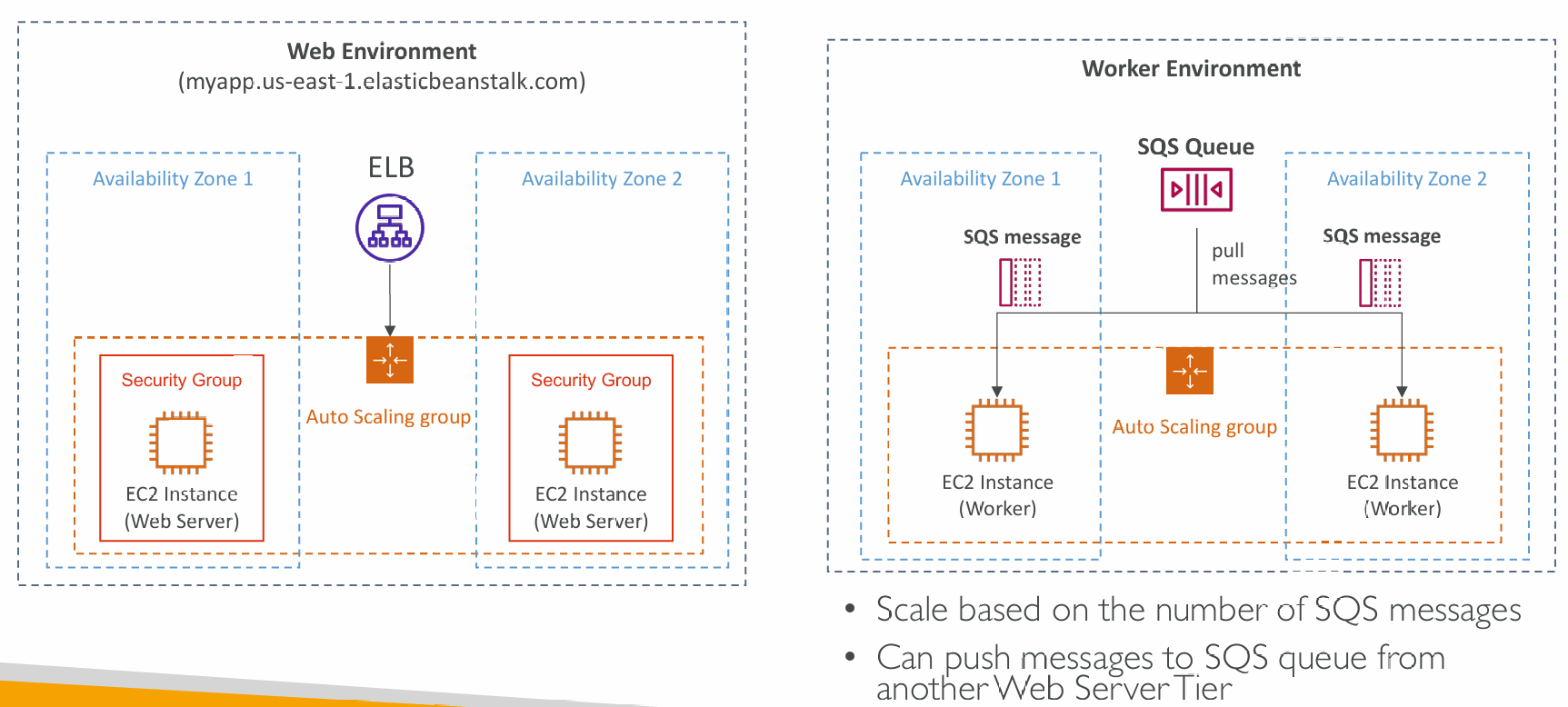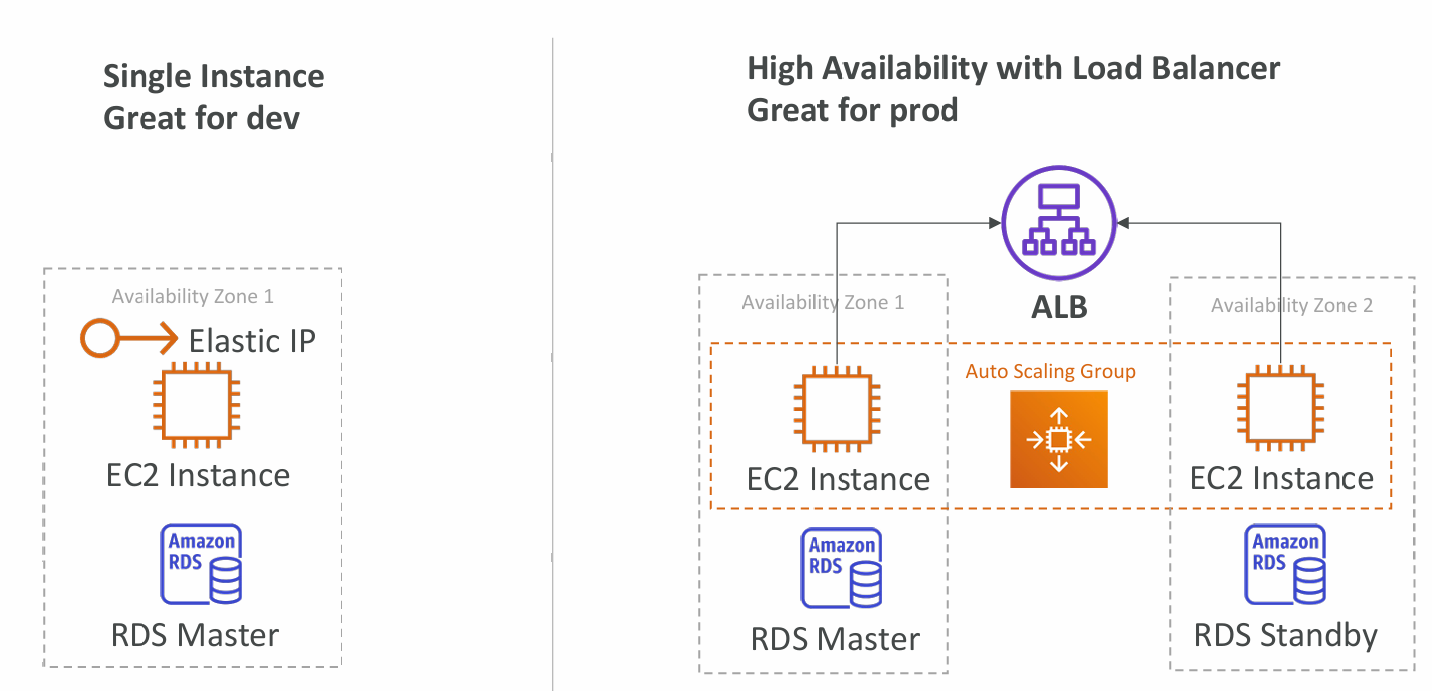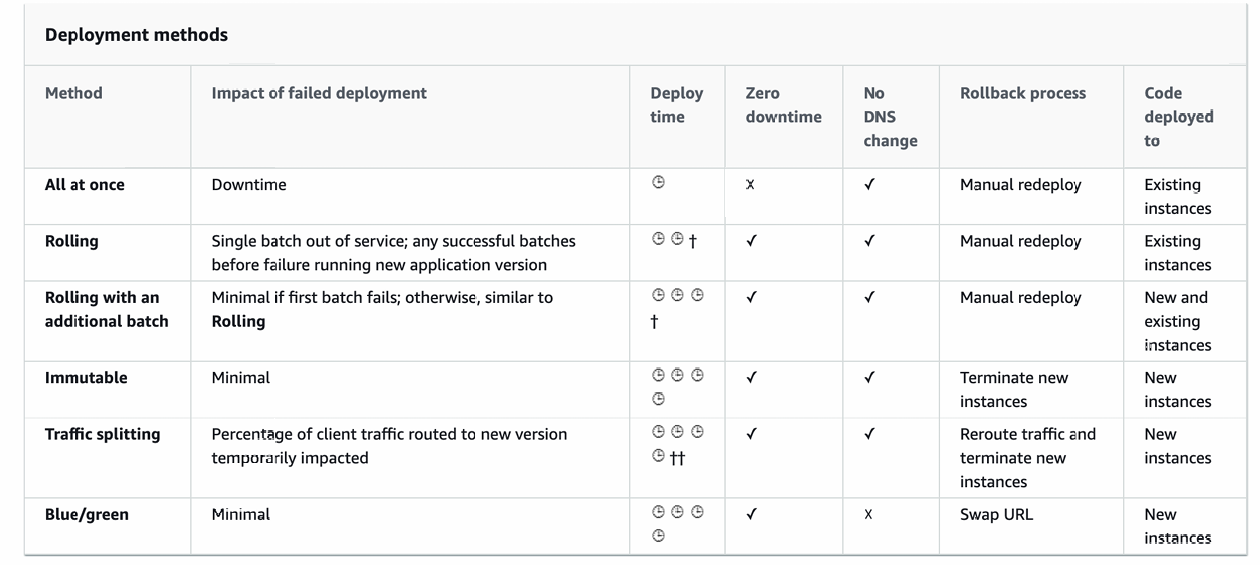- Uses all the component’s we’ve seen before: EC2, ASG, ELB, RDS
- Managed service
- Automatically handles capacity provisioning, load balancing, scaling, application health monitoring, instance configuration, …
- Just the application code is the responsibility of the developer
- We still have full control over the configuration
- Beanstalk is free but you pay for the underlying instances
Components
- Application: collection of Elastic Beanstalk components (environments, versions, configurations, …)
- Application Version: an iteration of your application code
- Environment
- Collection of AWS resources running an application version (only one application version at a time)
- Tiers: Web Server Environment Tier & Worker Environment Tier
- You can create multiple environments (dev, test, prod, …)

Web Server Tier vs. Worker Tier

Deployment Modes

Deployment Options for Updates
- All at once (deploy all in one go) – fastest, but instances aren’t available to serve traffic for a bit (downtime)
- fastest
- Application has downtime
- No additional cost
- Rolling: update a few instances at a time (bucket), and then move onto the next bucket once the first bucket is healthy
- Application is running below capacity
- Can set the bucket size
- Application is running both versions simultaneously
- No additional cost
- Long deployment
- Rolling with additional batches: like rolling, but spins up new instances to move the batch (so that the old application is still available)
- Application is running at capacity
- Can set the bucket size
- Application is running both versions simultaneously
- Small additional cost
- Additional batch is removed at the end of the deployment
- Good for prod
- Immutable: spins up new instances in a new ASG, deploys version to these instances, and then swaps all the instances when everything is healthy
- Zero downtime
- New Code is deployed to new instances on a temporary ASG
- High cost, double capacity
- Longest deployment
- Quick rollback in case of failures (just terminate new ASG)
- Great for prod
- Blue Green: create a new environment and switch over when ready
- Not a “direct feature” of Elastic Beanstalk
- Zero downtime and release facility
- Create a new “stage” environment and deploy v2 there
- The new environment (green) can be validated independently and roll back if issues
- Route 53 can be setup using weighted policies to redirect a little bit of traffic to the stage environment
- Using Beanstalk, “swap URLs” when done with the environment test
- Traffic Splitting: canary testing – send a small % of traffic to new deployment
- Canary Testing
- New application version is deployed to a temporary ASG with the same capacity
- A small % of traffic is sent to the temporary ASG for a configurable amount of time
- Deployment health is monitored
- If there’s a deployment failure, this triggers an automated rollback (very quick)
- No application downtime
- New instances are migrated from the temporary to the original ASG
- Old application version is then terminated
Deployment Modes - Summary

Deployment Process
- Describe dependencies (requirements.txt for Python, package.json for Node.js)
- Package code as zip, and describe dependencies
- Python: requirements.txt
- Node.js: package.json
- Console: upload zip file (creates new app version), and then deploy
- CLI: create new app version using CLI (uploads zip), and then deploy
- Elastic Beanstalk will deploy the zip on each EC2 instance, resolve dependencies and start the application
Lifecycle Policy
- Elastic Beanstalk can store at most 1000 application versions
- If you don’t remove old versions, you won’t be able to deploy anymore
- To phase out old application versions, use a lifecycle policy
- Based on time (old versions are removed)
- Based on space (when you have too many versions)
- Versions that are currently used won’t be deleted
- Option not to delete the source bundle in S3 to prevent data loss
Elastic Beanstalk CLI
- We can install an additional CLI called the “EB cli” which makes working with Beanstalk from the CLI easier
- Basic commands are:
- eb create
- eb status
- eb health
- eb events
- eb logs
- eb open
- eb deploy
- eb config
- eb terminate
- It’s helpful for your automated deployment pipelines!
Elastic Beanstalk Extensions
- A zip file containing our code must be deployed to Elastic Beanstalk
- All the parameters set in the UI can be configured with code using files
- Requirements:
- in the .ebextensions/ directory in the root of source code
- YAML / JSON format
- .config extensions (example: logging.config)
- Able to modify some default settings using: option_settings
- Ability to add resources such as RDS, ElastiCache, DynamoDB, etc…
- Resources managed by .ebextensions get deleted if the environment goes away
Under the Hood
- Under the hood, Elastic Beanstalk relies on CloudFormation
- CloudFormation is used to provision other AWS services (we’ll see later)
- Use case: you can define CloudFormation resources in your .ebextensions to provision ElastiCache, an S3 bucket, anything you want!
Cloning
- Clone an environment with the exact same configuration
- Useful for deploying a “test” version of your application
- All resources and configuration are preserved:
- Load Balancer type and configuration
- RDS database type (but the data is not preserved)
- Environment variables
- After cloning an environment, you can change settings
Migration: Load Balancer
- After creating an Elastic Beanstalk environment, you cannot change the Elastic Load Balancer type (only the configuration)
- To migrate:
- create a new environment with the same configuration except LB (can’t clone)
- deploy your application onto the new environment
- perform a CNAME swap or Route 53 update
RDS with Elastic Beanstalk
- RDS can be provisioned with Beanstalk, which is great for dev / test
- This is not great for prod as the database lifecycle is tied to the Beanstalk environment lifecycle
- The best for prod is to separately create an RDS database and provide our EB application with the connection string
Migration
- Create a snapshot of RDS DB (as a safeguard)
- Go to the RDS console and protect the RDS database from deletion
- Create a new Elastic Beanstalk environment, without RDS, point your application to existing RDS
- perform a CNAME swap (blue/green) or Route 53 update, confirm working
- Terminate the old environment (RDS won’t be deleted)
- Delete CloudFormation stack (in DELETE_FAILED state)



